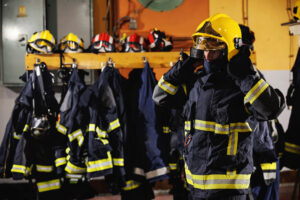 The OPS-X Simulation Series revolutionizes Power System Operations training by way of a hands-on simulation environment. One objective of this software is to place the operators out of their comfort zone, in unfamiliar circumstances. Challenged with a skinny power system, at faster than real time, operators immediately develop and test their natural instincts and reactions to real life situations. System simulations greatly enhance the training experience and improves the retention of the material.
The OPS-X Simulation Series revolutionizes Power System Operations training by way of a hands-on simulation environment. One objective of this software is to place the operators out of their comfort zone, in unfamiliar circumstances. Challenged with a skinny power system, at faster than real time, operators immediately develop and test their natural instincts and reactions to real life situations. System simulations greatly enhance the training experience and improves the retention of the material.
The Simulation series now comprises of 8 training modules for a total of 64 NERC Continuing Education Hours (CEH’s), 51 Simulation hours and 58 NERC Standard hours. Each module targets a specific area of Power System Operation.
Renewable System Operations is the 8th module, newly completed and released. The simulation exercise provides 8 CEH and covers Operating Reserve; Congestion Mitigation; and Voltage Support.
 As part of our commitment to making workplace training accessible for everyone, we’re excited to announce the launch of Spanish versions of the newly updated Driving Safety courses! These courses are designed to equip Spanish-speaking employees with the essential knowledge they need to drive safely, whether they’re commuting, using a company vehicle, or navigating challenging road conditions.
As part of our commitment to making workplace training accessible for everyone, we’re excited to announce the launch of Spanish versions of the newly updated Driving Safety courses! These courses are designed to equip Spanish-speaking employees with the essential knowledge they need to drive safely, whether they’re commuting, using a company vehicle, or navigating challenging road conditions.
 A recent study from Monash University has revealed a troubling increase in silicosis cases within Australia’s stone countertop industry. Silicosis, a progressive and incurable lung disease, is caused by exposure to respirable crystalline silica, a common hazard in many industrial and construction environments.
A recent study from Monash University has revealed a troubling increase in silicosis cases within Australia’s stone countertop industry. Silicosis, a progressive and incurable lung disease, is caused by exposure to respirable crystalline silica, a common hazard in many industrial and construction environments.
This alarming trend highlights the critical need for workplace silica safety training. Workers must understand the dangers of silica dust exposure and implement proper safety practices to protect their health.
Prevent silica exposure with expert safety training with the Silica Safety in Industrial and Construction Environments Training Course. The module has been designed to help workers identify silica hazards, follow best practices, and reduce their risk of developing silicosis.
Ensure your team has the knowledge and skills to work safely. Invest in silica safety training today to protect your workforce from irreversible health risks.
 A recent report from the Center for Construction Research and Training (CPWR) reveals a concerning rise in fatalities among Hispanic construction workers. Between 2011 and 2022, the death rate for Hispanic workers in construction has doubled, while non-Hispanic fatalities have increased by only 16.5%.
A recent report from the Center for Construction Research and Training (CPWR) reveals a concerning rise in fatalities among Hispanic construction workers. Between 2011 and 2022, the death rate for Hispanic workers in construction has doubled, while non-Hispanic fatalities have increased by only 16.5%.
Why Are Hispanic Construction Workers at Greater Risk? One of the leading factors contributing to this disparity is the lack of safety training materials in Spanish. Without access to essential construction safety courses, many Hispanic workers may struggle to understand critical workplace safety protocols, increasing their risk of accidents and fatalities.
We recognize the urgent need for Spanish-language workplace safety training in the industry. For this reason, the continuation of translating every course in the Construction Safety library is crucial and available soon to ensure that every worker, regardless of language, has access to life-saving safety information.
Providing Spanish-language construction safety courses is not just a necessity – it’s a lifesaving initiative. Employers can help reduce workplace fatalities by ensuring that all workers receive proper safety education in their native language.
 Working in high temperatures is unavoidable in many industries, but heat-related illnesses don’t have to be. Proper preparation, safe work practices, and effective engineering controls are key to staying protected. Fortunately, California’s Heat Illness Prevention Standards – for both indoor and outdoor workplaces, offer clear guidelines to help workers beat the heat and stay safe on the job.
Working in high temperatures is unavoidable in many industries, but heat-related illnesses don’t have to be. Proper preparation, safe work practices, and effective engineering controls are key to staying protected. Fortunately, California’s Heat Illness Prevention Standards – for both indoor and outdoor workplaces, offer clear guidelines to help workers beat the heat and stay safe on the job.
To support businesses in safeguarding their teams, the new Heat Illness Prevention for California Workplaces training course training course equips employees with the latest insights on California’s heat safety regulations, best practices for heat illness prevention, and actionable strategies to stay cool and compliant.
Information contained in this course includes how heat affects the body which can lead to heat-related illnesses. It also provides practical guidance on how to comply with California’s indoor and outdoor Heat Illness Prevention Standards, as well as reviews what workers can do to help prevent heat-related illnesses.
Invest in safety and compliance – empower your workforce with the knowledge to prevent heat stress, reduce risks, and ensure a safe work environment all year round.
 The sUAS Thermography Level 1 Certification Course has been produced by professional thermographers with over 40 years’ experience and provides practical techniques for beginners and experienced thermographers wishing to get the most from their drone-based thermal imaging system for infrared drone inspections.
The sUAS Thermography Level 1 Certification Course has been produced by professional thermographers with over 40 years’ experience and provides practical techniques for beginners and experienced thermographers wishing to get the most from their drone-based thermal imaging system for infrared drone inspections.
The online course covers infrared theory, heat transfer concepts, equipment operation, and temperature measurement using drone-based thermal imaging equipment. It also covers several applications including infrared inspections of electrical systems, mechanical systems, photovoltaic installations, underground piping, building envelopes, low-slope roofing systems, and environmental studies.
Students who successfully complete the course receive an sUAS Thermographer Certification which will qualify them to further their training with Level 2 and Level 3 thermography certification courses.
 Many companies rely on compressed gas cylinders for the storage, use, and transportation of gases. However, without proper safety protocols, mishandling these cylinders can lead to serious accidents, sometimes even explosive incidents. By implementing safe handling, transportation, and maintenance practices, businesses can significantly reduce the risk of such incidents.
Many companies rely on compressed gas cylinders for the storage, use, and transportation of gases. However, without proper safety protocols, mishandling these cylinders can lead to serious accidents, sometimes even explosive incidents. By implementing safe handling, transportation, and maintenance practices, businesses can significantly reduce the risk of such incidents.
To support organizations in maintaining a safe work environment, we are excited to introduce new Compressed Gas Cylinders training courses. These comprehensive courses are designed to equip employees with the most current knowledge and best practices for safely working with compressed gas cylinders.
In our ongoing commitment to providing industry-specific safety training, five specialized courses have been developed, focusing on compressed gas cylinder safety. Each course is tailored to a particular industry, offering relevant insights into the potential hazards associated with compressed gas cylinders and practical strategies for managing them. The courses feature interactive videos and industry-specific terminology to ensure employees fully understand the unique challenges of their specific work environments.
These new courses use a powerful combination of full-motion, high-definition video filmed in real world locations, along with audio, text, and colorful graphics to provide the most cost-effective training available in the industry.
 Every year, a significant number of employees are injured at work due to hazards that are not properly recognized. To ensure the safety of all workers and guarantee they return home unharmed, it is essential that they are fully informed about the potential hazards they may encounter and understand how to manage them effectively. When hazards are ignored or employees are inadequately prepared, the risk of accidents and disasters increases.
Every year, a significant number of employees are injured at work due to hazards that are not properly recognized. To ensure the safety of all workers and guarantee they return home unharmed, it is essential that they are fully informed about the potential hazards they may encounter and understand how to manage them effectively. When hazards are ignored or employees are inadequately prepared, the risk of accidents and disasters increases.
To support organizations in addressing this issue, we are proud to introduce the newly released Hazard Recognition training courses. These programs have been specifically designed to equip employees with the most current information and best practices for identifying and mitigating hazards in the workplace.
Seven industry-specific Hazard Recognition training courses are available, each tailored to offer valuable insights into the best methods for hazard preparation and management, with content that includes videos and terminology reflective of the specific environments and operations within each industry.
These new courses use a powerful combination of full-motion, high-definition video filmed in real world locations, along with audio, text, and colorful graphics to provide the most cost-effective training available in the industry.
All versions of the courses are currently available online in Full-Length Interactive, Adaptive Learning, Micro-Learning formats and Video On Demand (VOD) for streaming over the internet. DVDs that can be played locally at your facility are also available.
 The new Electric Power System Reliability Textbook 2025 edition includes the latest material and revised NERC Standards for anyone seeking a career as an Electric Power System Operator. The book incorporates the current exam application and analysis type questions. The textbook is updated every year to include new and revised standards to prepare students for the NERC System Operator Exam.
The new Electric Power System Reliability Textbook 2025 edition includes the latest material and revised NERC Standards for anyone seeking a career as an Electric Power System Operator. The book incorporates the current exam application and analysis type questions. The textbook is updated every year to include new and revised standards to prepare students for the NERC System Operator Exam.
Two versions of the cleaning and sanitizing training courses are now available in Spanish:

All versions use a powerful combination of full-motion, high-definition video filmed in real world locations, along with audio, text, and colorful graphics.
Both courses are available online in Full-Length Interactive, Adaptive Learning, Micro-Learning, DVD and Video On Demand (VOD) formats for streaming over the internet.

Organizations are increasingly recognizing the critical importance of diversity in the workplace. Also, it is important to gain an understanding that having a workforce that consists of employees with diverse experiences, backgrounds, and skills can contribute to greater organizational success. Furthermore, when employees perceive their workplace as lacking a supportive and respectful culture, they are significantly more likely to seek opportunities elsewhere. This highlights the need for all individuals within the organization to have a clear understanding of diversity, equity, inclusion, and belonging and to actively contribute to the success of DEIB initiatives.
Seven versions of the course have been completed and are now available. Each version features video and terminology that demonstrate the environment and operations of a specific industry.
These modules use a powerful combination of full-motion, high-definition video filmed in real world locations, along with audio, text, and colorful graphics.
All courses are available online in Full-Length Interactive, Adaptive Learning, Micro-Learning, Video On Demand (VOD) for streaming over the internet and DVD formats.

Organizations are recognizing the importance of having a diverse workforce and the ensuring everyone does their part to make their co-workers feel welcome, valued and included. The new Diversity, Equity, Inclusion and Belonging training courses will offer current information about what DEIB is and how to practice it in the workplace.

One of the top priorities for the food industry is ensuring cleanliness practices are followed in their facilities. A contaminated product can cost an organization money, time, and customers. Therefore, it is pertinent that every employee must understand how to properly clean and sanitize equipment that they work with, as well as their work areas.
This month we will be offering Spanish versions for the cleaning and sanitizing courses to include:

Now available are seven versions the Workplace Violence training that contains valuable information about the warning signs of violence and how to handle aggressive and violent behavior if it does occur.
These courses have been designed to provide Spanish-speaking employees, managers and supervisors with strategies to help them recognize, handle and report violence. All versions use a powerful combination of full-motion, high-definition video filmed in real world locations, along with audio, text, and colorful graphics.
Also, the two Workplace Violence in California courses that have been previously released include pertinent information about how organizations can comply with California’s SB 553 Workplace Violence Prevention Bill.

The new Personal Safety for CMV Drivers training course has been designed to provide employees with the most up-to-date information about the hazards that CMV drivers face and how they can protect themselves on the road.
Topics covered include how drivers can take care of themselves while they’re on the road; ways that they can prepare before a trip; tips for responsible driving and a practical guidance on how to anticipate potential threats, and what drivers should do if they’re confronted by a violent criminal.

The Universal Waste training course has been fully translated into Spanish and discusses the types of hazardous materials that are considered to be universal waste, and how to handle and dispose of them according to the EPA Universal Waste Regulation.
Disposing of hazardous waste can be a long and complicated process, but some hazardous waste materials are less harmful to people and the environment than others. Therefore, to make it easier to recycle these low-risk hazardous waste materials, the EPA created a different class of hazardous waste called universal waste. Although the criteria for their disposal aren’t as strict as for other hazardous wastes, there are still processes and procedures that must be followed to ensure that they are handled and transported safely.

The Slips, Trips and Falls Spanish training courses have been designed to provide employees with strategies to help them avoid the injuries that they can sustain at the workplace.
Seven versions of the course contain valuable information about the dangers of slips, trips and falls and how to maintain balance on-the-job. Each version features video and terminology that shows the environment and operations of a specific industry.
These modules use a powerful combination of full-motion, high-definition video filmed in real world locations, along with audio, text, and colorful graphics.
Both courses are available online in Full-Length Interactive, Adaptive Learning, Micro-Learning, Video On Demand (VOD) for streaming over the internet and DVD formats.

Two newly released courses on California’s SB553 dealing with Workplace Violence discusses the different types of violence employees can encounter in the workplace, the warning signs they can look for, and how to handle aggressive or violent behaviour if it does occur. The course also provides practical guidance on how to implement a Workplace Violence Prevention Plan that complies with California’s SB553 Bill.
Both courses are available online in Full-Length Interactive, Adaptive Learning, Micro-Learning, Video On Demand (VOD) for streaming over the internet and DVD formats.

The Fatigue and Its Effects for CMV Drivers and Preventing and Managing Fatigue for CMV Drivers courses have been completely translated into Spanish and are now available. These courses will help all CMV drivers stay awake, alert, and safe on the road.
These modules use a powerful combination of full-motion, high-definition video filmed in real world locations, along with audio, text, and colorful graphics.
Both courses are available online in Full-Length Interactive, Adaptive Learning, Micro-Learning, Video On Demand (VOD) for streaming over the internet and DVD formats.

As part of a program coordinated by the Federal Motor Carrier Safety Administration, the Canadian Council of Motor Transport Administrators, and Mexico’s National Guard and Ministry of Communications and Transportation, commercial motor vehicle inspectors across North America will conduct brake system inspections during “Brake Safety Week” from August 25 – 31, 2024.
CMV drivers need to know how to inspect and maintain their trucks’ brakes and other components, year-round. The DOT Commercial Motor Vehicle Inspections training course assists CMV drivers to learn about the FMSCA’s inspection and maintenance regulations and how they can comply with them.

Any CMV driver can experience driver fatigue which can lead to devasting or deadly accidents. To help prevent this, two new CMV Driver Fatigue courses will be released in Spanish: Fatigue and Its Effects for CMV Drivers and Preventing and Managing Fatigue for CMV Drivers. These courses will help all CMV drivers stay awake, alert, and safe on the road.

The Environmental Protection Agency considers batteries, light bulbs and aerosol cans to be Universal Waste when they are no longer working. The EPA has very specific regulatory requirements for their disposal. To assist workers in understanding the requirements for proper disposal, the Universal Waste course will be translated and released in Spanish next month.

Spanish versions of the Forklift Safety training courses are now available. These four courses have been designed to provide Spanish-speaking workers with vital information about safe forklift operating procedures and how to avoid injuries while working around forklifts.
These courses offer vital information about driving, maintaining, and working around forklifts for both operators and pedestrians. They also cover OSHA’s training requirements and important safe operating procedures for forklifts.

California recently passed Senate Bill 553, which requires employers to have a written Workplace Violence Prevention Plan, provide employees with annual training, and keep a Violent Incident Log. To help California companies better understand the Bill and its’ requirements, two new training programs will be released in the next few months will include: Workplace Violence for California Employees, and Workplace Violence for California Managers and Supervisors.

Over the next few months, Spanish Heavy equipment accidents cause thousands of injuries a year. Twelve new Heavy Equipment Safety modules in development will provide vital information to help keep workers safe while they’re operating and working around these machines. Courses will include Backhoe Safety, Bulldozer Safety, Front-End Loader Safety, Dump Truck Safety, Excavator Safety, and Skid Steer Safety.

Anyone can slip, trip or fall on a walking or working surface. The new Spanish version of the Walking and Working Surfaces training course teaches workers how to safely navigate walking and working surfaces while avoiding the hazards associated with them.

Over the next few months, Spanish versions of Walking and Working Surfaces, Forklift Safety, CMV Driver Fatigue, and Universal Waste training courses will be released.
These new courses will include a powerful combination of full-motion, high-definition video filmed in real world locations, along with audio, text and colorful graphics.
Formats include online in Full-Length Interactive, Adaptive Learning, Micro-Learning, Video On Demand (VOD) for streaming over the internet and DVDs.

Commercial Motor Vehicle drivers know how challenging it can be to maneuver a large vehicle, especially when traveling in reverse. Since it can be difficult to see where you’re going, it takes extra preparation, skill and concentration to maneuver safely. This only becomes more complicated when a driver can’t approach a parking space “straight on”. In these circumstances, a driver should use alley docking. However, alley docking can be tricky, so perfecting this maneuver takes time, practice, and patience.
To assist organizations in dealing with these challenges, two new courses have been completed for Backing Basics and Straight Line, Offset and Parallel Parking for CMV Drivers, and Backing Basics and Alley Dock Parking for CMV Drivers. These courses discuss the basics of backing and parking and how to perform these maneuvers in a Commercial Motor Vehicle as well as common hazards to look for while backing and parking a CMV and how to avoid them.
English formats include online in Full-Length Interactive, Adaptive Learning, Micro-Learning, Video On Demand (VOD) for streaming over the internet and DVDs. Spanish versions of the courses will be completed soon.

Emergencies at the workplace can occur from natural causes, human error, medical issues, gas leaks, fires, explosions, hurricanes, floods, riots, acts of terrorism, etc.
To assist companies in deal with these potential issues, we are pleased to announce the release of the new Emergency Planning training courses.
Six versions of the Emergency Planning courses are now that feature video and terminology for environments and operations for specific industries.
Information contained in these courses includes new content on creating an emergency plan, the threat of terrorism, active shooter situations, your role in emergency planning as well as the process of emergency action drills and your part in them.
These new courses use a powerful combination of full-motion, high-definition video filmed in real world locations, along with audio, text and colourful graphics.
Formats include online in Full-Length Interactive, Adaptive Learning, Micro-Learning, Video On Demand (VOD) for streaming over the internet and DVDs. Spanish versions of the courses will be released in the upcoming months.

During the week of May 6 -10, 2024, OSHA will be encouraging employers to have their workers’ attention focus on fall hazards in construction zones and how to avoid them. To assist your organization with this focus, the Fall Protection training course has been developed to increase awareness for this topic, and help prevent employees from suffering fall-related injuries.

The Reasonable Suspicion Drug and Alcohol Testing for CDL Drivers courses have been translated into Spanish. The courses cover vital information for drivers, supervisors and managers about drug and alcohol testing and how to learn to comply with updated DOT testing regulations. Topics covered include the testing process, what to do if a driver tests positive for a substance and how to get help for a driver who is experiencing a drug or alcohol use disorder.
These new courses use a powerful combination of full-motion, high-definition video filmed in real world locations, along with audio, text and colorful graphics.
Formats include online in Full-Length Interactive, Adaptive Learning, Micro-Learning, Video On Demand (VOD) for streaming over the internet and DVDs.

Backing up and parking are some of the hardest, but most important, skills that CDL drivers have to master. The new Backing and Parking for CDL Drivers training course will break down the most used backing and parking maneuvers and will provide detailed information to assist drivers to perform these skills safely. The course will also discuss hazards they should be aware of as they park their vehicles.
Compressed gas cylinders are used in many industries, but they can also be very dangerous. Therefore, it is important that employees understand the hazards associated with gas cylinders and the safe work practices they can use to avoid them. The new course will examine how workers should handle, transport, and install compressed gas cylinders safely in their work environments.

The new Learning Management System software has now been rolled out and provides a powerful and streamlined platform to manage the learning experience within your organization.
Intuitive User Interface: Our revamped interface is much more “visual” and ensures a seamless and user-friendly experience, making navigation a breeze for both learners and
instructors.
Enhanced Course Management: Organizing and managing courses is now more efficient than ever. Administrators can easily assign, group and schedule courses, while learners experience a clear and structured path through their learning materials.
Responsive Design: The new LMS is optimized for multiple devices, including desktops, tablets, and smartphones, allowing administrators and learners to access your courses whenever and wherever it’s convenient for them.
Improved Collaboration Tools: Foster collaboration and interaction with an enhanced message system, promoting a dynamic and engaging learning environment.
Advanced Analytics: Learners can track their progress and performance with the
upgraded analytics tools. Administrators can also gain valuable insights into learner
engagement and performance, enabling them to tailor employees’ curricula and training experiences for optimal results.
Simplified User Management: Effortlessly manage user accounts, roles, and
permissions with our refined user management system. Streamlined processes ensure efficient control over the LMS, making administrative tasks more straightforward.
Enhanced Reporting Tools: Gain deeper insights into user engagement, course completion rates, and overall system utilization. The upgraded reporting tools provide administrators with comprehensive analytics to assess the effectiveness of the courses.
Automated Notifications: Learners are informed about critical events within the LMS through automated notifications. They receive updates on user progress, course completions, and any system-related alerts, allowing proactive management of the learning environment.
Seamless Integration: The new LMS now offers enhanced compatibility with other tools and systems, facilitating smoother data flow and integration with existing administrative processes.

Human bodies are strong, flexible and capable of performing a variety of demanding tasks. However, heat stress can interfere with its natural processes. When this occurs, the results can be serious, even fatal.
To help companies deal with this, we are pleased to announce the release of the newly “Heat Stress” training courses. These courses have been designed to provide employees with the most up-to-date information and best practices for working safely in the heat.
Six industry-specific training courses have been created that contain valuable information about the best ways to prepare for and work in the heat. Each version contains video and terminology that displays the environment and operations of a specific industry.
Titles include:
Information contained in these courses includes how the body’s cooling system operates and responds to heat, types of heat-related illnesses and how to treat them, and how to prepare to work in hot environments safely. They also provide practical guidance on how to assist coworkers suffering from heat-related illnesses.
These new courses use a powerful combination of full-motion, high-definition video filmed in real world locations, along with audio, text, and colorful graphics.
The English version of the courses is currently available online in Full-Length Interactive, Adaptive Learning, Micro-Learning, and Video On Demand (VOD) formats for streaming over the internet. DVDs that can be played locally at your facility are also available. Also, Spanish versions of the courses will be completed and released soon.

The new Dealing with Allergens in Food Processing and Handling Environments training course provides current information and best practices for dealing with allergen-related issues.
According to the Centers for Disease Control and Prevention (CDC), food allergies affect almost 6% of adults and children in the United States. This statistic represents millions of allergy sufferers. Protecting people with these types of allergies is an extremely important, but also very complex, task. Upon completion of the course, employees will know what they can do to help protect products and consumers from food allergens.
The course covers what allergens are; their role in the food supply chain; and how to avoid cross-contamination throughout the food manufacturing and handling processes. The program also addresses relevant FDA regulations and how to establish sanitation and cleaning protocols.
The course uses a powerful combination of full-motion, high-definition video filmed in real world locations, along with audio, text and colourful graphics.
The English versions of the course are currently available online in Full-Length Interactive, Adaptive Learning, Micro-Learning, Video on Demand (VOD) and DVD formats. The Spanish version will be released in the coming months.

The DC Brushed Motor Maintenance module describes the purpose of the components that make up a DC motor, some troubleshooting techniques, inspection and cleaning procedures, and how to disassemble and reassemble a typical motor.

Two highly interactive courses have been fully updated covering shaft alignment to make shaft alignment maintenance easier and safer for architecture, engineering, construction (AEC), facilities management, and industrial manufacturing workforce.
Titles include:
The Shaft Alignment – Tools and Methods course covers typical alignment tools, preparation steps, and standard alignment procedures.
The Shaft Alignment – Types and Causes of Misalignment course covers the different types of misalignments, how to recognize misalignment, and the conditions that cause misalignment.

Healthcare facilities can contain many harmful organisms, such as bacteria, fungi and viruses. If people are exposed to these pathogens, they can develop an infection that could easily spread to others, posing a threat to the health of everyone in your facility. However, if the proper procedures are followed, you can help to control the spread of these organisms and ensure a safe and healthy environment for everyone.
The new Infection Control in Healthcare Environments courses help healthcare facilities deal with this important issue. These courses discuss the importance of infection control in healthcare environments, the rules and regulations that you must adhere to, and what you can do to help keep everyone in your facility infection-free.
Versions of the course include:
Information contained in these courses includes new content on facility hygiene, your role in controlling the spread of infection, infection control guidelines and regulations, protecting patients, and more!
The English version of the courses are currently available online in Full-Length Interactive, Adaptive Learning, Micro-Learning formats and Video On Demand (VOD) for streaming over the internet. DVDs/USBs that can be played locally at your facility are also available. Spanish versions of the courses will be available soon.
 The DOT has recently updated its Drug and Alcohol testing regulations to include oral fluids testing as an approved method for drug and alcohol testing. These courses offer fresh information for organizations that need to help managers and supervisors understand the testing process, know what to do if a driver tests positive for a substance and how to get help for a driver who is experiencing a drug or alcohol use disorder. The courses have been specifically designed to provide drivers, managers and supervisors with the understanding and tools they need to navigate the complexities of employee drug and alcohol testing. The courses that have been updated with this new information include:
The DOT has recently updated its Drug and Alcohol testing regulations to include oral fluids testing as an approved method for drug and alcohol testing. These courses offer fresh information for organizations that need to help managers and supervisors understand the testing process, know what to do if a driver tests positive for a substance and how to get help for a driver who is experiencing a drug or alcohol use disorder. The courses have been specifically designed to provide drivers, managers and supervisors with the understanding and tools they need to navigate the complexities of employee drug and alcohol testing. The courses that have been updated with this new information include:These new courses use a powerful combination of full-motion, high-definition video filmed in real world locations, along with audio, text, and colorful graphics to provide the most cost-effective training available in the industry.
The English version of the courses are currently available online in Full-Length Interactive, Adaptive Learning, Micro-Learning formats and Video On Demand (VOD) for streaming over the internet. DVDs that can be played locally at your facility are also available. Spanish versions of the courses will be available shortly.
 The Back Safety courses have been designed to provide Spanish-speaking employees with the tools they need to avoid the injuries that can lead to back pain. Eight versions of the course have been released that that contain valuable information about the best ways to understand and safeguard employees’ backs. Each version features video and terminology that shows the environment and operations of a specific industry. Titles include:
The Back Safety courses have been designed to provide Spanish-speaking employees with the tools they need to avoid the injuries that can lead to back pain. Eight versions of the course have been released that that contain valuable information about the best ways to understand and safeguard employees’ backs. Each version features video and terminology that shows the environment and operations of a specific industry. Titles include:Information contained in these courses includes content on how the back works, the types of back injuries, better posture for a healthier back, how to lift things safely, and taking care of the back.
 OSHA has recently updated its’ Recordkeeping regulation. The changes are effective on January 1st, 2024. Updates to this regulation include requiring certain companies in high hazard industries and who have 100 or more employees to electronically submit Forms 300 and 301 by March 2nd of each year. OSHA intends to use this collected information to more accurately identify trends and patterns in companies’ recordkeeping activities to better allocate its enforcement and compliance assistance resources. The newly updated OSHA Recordkeeping for Employees and OSHA Recordkeeping for Managers and Supervisors training courses reflect these recent changes and also look at how the OSHA requirements apply in real workplace environments. The courses also discuss the types of injuries and illnesses that should be recorded and show employees, managers and supervisors how the OSHA-approved forms should be used so that the recordkeeping process runs smoothly.
OSHA has recently updated its’ Recordkeeping regulation. The changes are effective on January 1st, 2024. Updates to this regulation include requiring certain companies in high hazard industries and who have 100 or more employees to electronically submit Forms 300 and 301 by March 2nd of each year. OSHA intends to use this collected information to more accurately identify trends and patterns in companies’ recordkeeping activities to better allocate its enforcement and compliance assistance resources. The newly updated OSHA Recordkeeping for Employees and OSHA Recordkeeping for Managers and Supervisors training courses reflect these recent changes and also look at how the OSHA requirements apply in real workplace environments. The courses also discuss the types of injuries and illnesses that should be recorded and show employees, managers and supervisors how the OSHA-approved forms should be used so that the recordkeeping process runs smoothly.At Global Training Solutions Inc., we provide learning solutions for your specific organizational needs. Get in touch and let us help you create a high-impact training and development program.